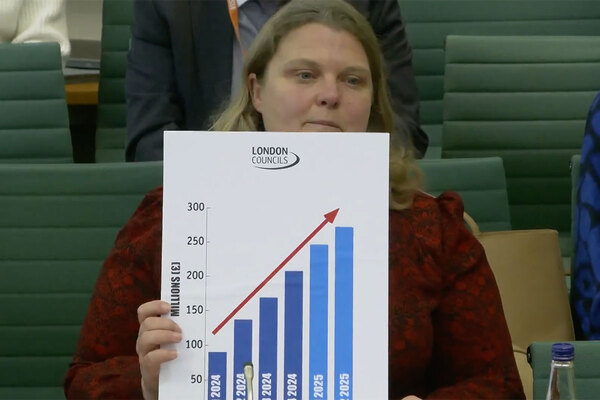 Jules Birch
Jules BirchAddison’s framework was scrapped but its legacy is more important than ever
The fortunes of council housing have ebbed and flowed ever since Addison’s programme was abruptly halted in 1921, writes Jules Birch
Inside Housing is publishing a number of articles this month to mark the centenary of the Addison Act, which paved the way for large-scale council housebuilding.
As we celebrate the centenary of what was effectively the birth of council housing in 1919, it’s also worth remembering what happened just two years later.
Lord Christopher Addison was the minister of health in the post-war coalition government of 1919 and it fell to him to deliver on the promise made by the Liberal prime minister, David Lloyd George, of ‘a country fit for heroes to live in’.
The Addison Act – officially The Housing, Town Planning etc Act 1919 – that received royal assent 100 years ago this month (I started the celebrations early) was the landmark legislation that established the principles of council housing and also set out housing’s role in the wider health and well-being of the country.
As the King’s Speech put it in April 1919: “It is not too much to say that an adequate solution of the housing question is the foundation of all social progress.”
As seen at the time, especially by Lord Addison himself as a surgeon before he became an MP, that housing question started with the consequences for health of the insanitary conditions and overcrowding suffered by millions of people.
The Addison Act provided generous subsidies for new council homes, but it also set a framework that ensured that slum landlords did not profit from slum clearance.
Yet just two years later, in July 1921, the housing programme was abruptly scrapped. Only 213,000 of the promised 500,000 homes were delivered and central government assistance to replace and improve slums was reduced to a grant of just £200,000 (around £11m in today’s money) for the whole of Great Britain.
These cuts were the result of a post-war drive against waste in public spending that culminated in the ‘Geddes Axe’, named after the businessman and Conservative politician who chaired the committee recommending what could be cut.
However, those whom Lord Addison called “the apostles of anti-waste” had a broader ideological agenda: to return the economy to ‘normal’ after increased state intervention during the war.
Addison resigned from the government in protest and eventually left the Liberals to join Labour. In 1922, he published his arguments for housing and against austerity in The Betrayal of the Slums.
In this righteously angry pamphlet, Lord Addison set out the insanitary conditions suffered by millions of people and the long-term costs to the country of poor housing.
At the time, there were 77,000 back-to-back houses in Leeds and almost a half a million people living in one or two rooms in Glasgow.
Under his act, the Treasury picked up all the costs of new council houses beyond what could be financed by a penny on the local rates.
He admitted that costs had escalated as a result of general inflation in building costs after the war, but said his warnings about the need for preparatory work to avoid cost increases had been ignored in the clamour for quicker progress.
Instead there had been a “sudden reaction”, he said. “Those who before had been loudest in their protests at the insufficient rapidity of our progress now became the foremost champions in the demand that the housing and slum reclamation projects should be abandoned.”
He also argued that costs were falling again by the time the programme was cancelled, and that they were in any case outweighed by wider benefits from employment and lower health and social costs.
As he put it: “It is difficult to argue how any body of rational beings could persevere in a policy of this kind at a time of such serious unemployment.”
Housing was trapped in a vicious circle. Private housebuilding could not revive in the face of continued restrictions on rents that were needed to keep them affordable in the face of a shortage of homes.
“Therefore, at one and the same time, the government prevents the accumulated shortage being made good by state or municipal assistance and, by prolonging the shortage, commits the community to the continued operation of that statute which effectively prevents its being met by private enterprise.”
The point of this historical diversion is partly to make the point that the framework established by the Addison Act only lasted for two years before being cut to virtually nothing. The fortunes of council housing have ebbed and flowed ever since.
The act’s legacy lies in the principles that it established to which future governments would return – notably the 1945-1951 Attlee government in which he served as a minister.
However, there is also a more contemporary point. The arguments that Lord Addison made are just as relevant now as they were then, especially when the austerity of the 2010s was the biggest squeeze on public spending since the anti-waste drive of the 1920s.
Austerity may be officially over and even Conservative politicians now say they are in favour of council housing. But a new prime minister, a new cabinet and Brexit lie ahead – who knows where that will lead?
“The act’s legacy lies in the principles that it established to which future governments would return”
The final chapter of Lord Addison’s pamphlet looks to the future. It starts with a quote from a letter from the town clerk of a metropolitan council to a man looking for accommodation for his family: “I have to inform you that there are at present no vacant houses on any of the council’s estates. Your application has been received, and these will be considered in the event of a vacancy occurring on any of the estates or when the houses now being erected are completed. There are at present about 6,000 applications on the file.”
If the echoes of contemporary waiting lists are hard to ignore, so too is Lord Addison’s portrayal of an £11m housing budget in 1922 (£600m in today’s money) of which half was subsidy to private builders – by comparison, expenditure on war services was £233m (£13bn).
The justifications for a social housing programme may be different now: the slums have largely been cleared and affordability and security are now seen as the biggest elements of the housing question.
But the case for decent housing and its wider economic and social benefits – not least for health – are just as relevant today as they were then.
And it’s hard to put that case better than Lord Addison himself did in 1922: “There is no direction in which the thrift, the contentment and the physical and intellectual capacity of our people can be more directly or plainly promoted than in this. It may be drab and unattractive in its detail, but in its nature and in its fulfilment, it is heroic. It is worthy of sacrifice and of all the powers of discipline and statesmanship that we possess.”
Jules Birch, award-winning blogger
100 Years of Council Housing: we want to hear from you
To mark the 100th anniversary of the act receiving Royal Assent in July, we have a month of special activities planned, including interviews with senior council housing figures, exclusive debate and comment, and investigations into what local authorities, past and present, are doing to help provide housing.
This will signal the start of a stronger focus on local authority housing issues over the coming months on www.insidehousing.co.uk and in our weekly print and digital editions.
We want to hear from you about your local authority is doing to mark the Addison Act and about the housing issues in your area, email: editorial@insidehousing.co.uk
Sign up to receive the latest housing news straight to your inbox through our exclusive Council Focus bulletin
If you are already a subscriber click here to manage your newsletter sign-ups
Click here to read more about our activity to mark the Addison Act
More council news
Council tenants on Universal Credit 16 times more likely to abandon tenancies
Council to claw back 260 Right to Buy homes
Local authorities accuse government of ‘sleight of hand’ over post-Hackitt regulation
Partner with housing associations to use borrowing freedoms, says LGA chair
Bristol City Council signs off partnership with L&G for 500-home scheme
Council boss warns against local authority ‘can't do’ attitude towards housebuilding
Right to Buy sales plummet 23%
Supreme Court rules against Birmingham Council in homelessness case
A bed every night: has Manchester's mayor succeeded in helping every rough sleeper in the city?
Council housing company to offer Rent to Buy
Council-owned regeneration company to build 500 homes
How has Haringey Council moved on from its development vehicle fight?
Liverpool to open HRA to build new council homes for first time in 30 years
How can London councils build more homes?
Birmingham Council’s housing company to build 2,708 homes by 2029
How are councils are using pension funds to build homes
More on the Addison Act
How George Clarke is aiming to end the housing crisis with his new TV show Architect George Clarke has long been a passionate campaigner for more – and better – council housing. As Inside Housing celebrates 100 years of the Addison Act, Martin Hilditch meets a man on a mission
100 Years of Council Housing: your tweets from week three Our favourite #100yearsofcouncilhousing tweets from the past seven days as our Addison Act activity moves into its fourth week
Nottingham's new wave Robyn Wilson goes to Nottingham to see what the next generation of council homes are set to look like.
If we’re going to have another 100 years of council housing, Right to Buy has to go The Right to Buy is having a devastating effect on the availability of council housing in this country and must be scrapped, writes Lee Sugden
What next for council housing? To celebrate the centenary of the Addison Act, Inside Housing asks a group of housing experts what can be learned from its legacy (sponsored)
Thatcher's legacy: a brief history of the Right to Buy An engine for social change or a handbrake on council development? We look at why the Right to Buy is as divisive as ever #ukhousing
A history of council housing: a timeline From the Addison Act to prefabs, slum clearance and the Right to Buy, council housing in the United Kingdom has a long and colourful history. Carl Brown looks at how it has evolved over time
Council housing: the key to a more equitable and dynamic society As the 100th anniversary of the Addison Act approaches, we publish an abridged extract of a book by Chris Matthews chronicling the history of council housing in Nottingham
Addison’s framework was scrapped but its legacy is more important than ever The fortunes of council housing have ebbed and flowed ever since Addison’s programme was abruptly halted in 1921, writes Jules Birch
Hulme: the redevelopment project that changed regeneration The redevelopment of Hulme in Manchester kick-started a new approach to regeneration in the UK – and the careers of some of housing’s best-known figures. Martin Hilditch joins them on a step back in time with lessons for today.
100 Years of Council Housing: your tweets from week two We pick our favourite #100yearsofcouncil housing tweets over the past week
Memories of council housing: the human legacy of the Addison Act As the centenary of the first council houses approaches, Peter Apps hears from some of the people who have lived in them in the decades since
Many of the sector’s current leaders began their journeys in council teams One hundred years of council housing has delivered a generation of sector leaders as well as millions of council homes, writes Mervyn Jones
Stevenage: home of the new town revolution Stevenage was the first of the post-war ‘new towns’. Gavriel Hollander visits the town to see how it has changed.
100 Years of Council Housing: your tweets from week one Inside Housing has been encouraging councils to say what they are doing to build homes and to mark 100 years of council housing. Here we feature a selection of your tweets
Kit Malthouse: 'Council housing is coming back with a vengeance' Housing minister Kit Malthouse tells Martin Hilditch why growing numbers of councils are looking to get back into development
Sea Mills: we visit one of the first estates to benefit from the Addison Act Social historian John Boughton visits a place in Bristol still cherished today
The Housing Podcast: is council housebuilding about to make a comeback Nearly 100 years after the introduction of the Addison Act, which kick-started the building of the first council estates in the UK, the Housing Podcast team examines the state of council housebuilding today
Why the 100th anniversary of the Addison Act should spark a council housing comeback Let’s make 2019 the start of a renaissance of council housing, writes Martin Hilditch
Are new borrowing freedoms sparking a revival of council housebuilding? The Addison Act marked the birth of council housebuilding. A century later, could recent financial freedom spark a renaissance? Nathaniel Barker investigates.
How Cornwall is taking inspiration from Christopher Addison Cornwall Council is one of many keeping the legacy alive, writes Kate Kennally.
The Addison Act - celebrating 100 years of council housing This year marks the 100th anniversary of the Addison Act – which paved the way for council housebuilding on a large scale. Inside Housing has a whole month of special activity planned and we want to hear your stories
The 100-year anniversary of the Addison Act means it’s time to talk about council housing Let’s use the 100th anniversary of council housing as we know it to flag up some of the great work that’s been done – and kick-start a conversation about the future, writes Martin Hilditch
London must recapture the housebuilding ambition of the Addison Act Councils are committed to development but are still facing unfair restrictions, writes Darren Rodwell of London Councils
Marking 100 years since the ‘Addison Act’ Professor Mark Swenarton writes about the Homes Fit for Heroes Centenary Conference
100 Years of Council Housing: what Inside Housing is doing
One hundred years ago, a piece of legislation led to the birth of council housing. Gavriel Hollander introduces Inside Housing’s celebration of the centenary of the Addison Act.
It is so ingrained in our national consciousness that it is hard to imagine just how radical the idea of local authority built and funded housing must have seemed a century ago. Before World War I, almost all housing in the UK was built by private developers (albeit with some notable municipal exceptions in major cities). Given this, it is unsurprising that both quality and consistency of delivery were variable.
The post-war introduction of subsidies for councils to solve the blight of slum estates was supposed to right a wrong and – in the words of then-prime minister David Lloyd George – provide “homes fit for heroes”.
The so-called Addison Act – the very first housing act passed in this country, named after its sponsor Dr (later Lord) Christopher Addison – received royal assent exactly 100 years ago this month.
It may never have achieved its aspiration of delivering 500,000 homes (something that may sound familiar to modern-day watchers of government housing policy) but it was the start of a movement.
New estates began to crop up across the country, built in accordance with recommendations from the Tudor Walters Report, which was produced to parliament in November 1918. This built on the ‘Garden City Principles’ and suggested a number of improvements to the standard of public housing. These included limiting the length of terraced-housing blocks, mandating a minimum number of rooms and providing indoor bathrooms.
“The post-war introduction of subsidies for councils to solve the blight of slum estates was supposed to right a wrong and – in the words of the prime minister David Lloyd George – provide ‘homes fit for heroes’”
Although the abandonment of subsidy in 1921 and a change of government the following year curtailed the immediate growth of council-built housing, the seed had been sown.
This month Inside Housing celebrates the centenary of the Addison Act with a month-long series of articles looking at how it transformed the social fabric of the country and created the housing sector we know today.
Over the course of this month, we visit four estates, each symbolising a different era of council housebuilding. We also take a look at whether new-found financial freedom for local authorities could be the catalyst for a new generation of estates.
To kick off the series, acclaimed social historian John Boughton visits one of the first estates made possible by Lord Addison’s historic legislation: Sea Mills in Bristol. We then travel to Stevenage to look at how the damage to Britain’s inner cities during the Blitz led to the new town movement and a fresh wave of estates through the 1950s and 1960s.
Martin Hilditch, editor of Inside Housing, takes a trip to Hulme in Manchester to examine how the private and public sector had to work together in the 1980s to deliver a regeneration project, which is still thriving more than 30 years later.
Finally, we go to Nottingham and look at one council with grand ambitions to provide housing to a new generation of tenants.
There may still be myriad challenges to face when it comes to providing good-quality, genuinely affordable housing for those most in need, but without the passing of an act of parliament 100 years ago, the sector we work in today may never have come to exist. That alone is worth celebrating.
To read more about the act, go to: www.insidehousing.co.uk/AddisonAct














